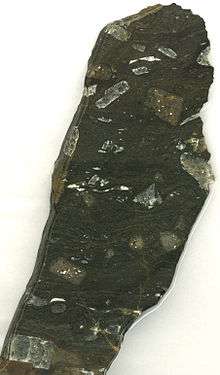Kenyte
Kenyte is a variety of porphyritic phonolite or trachyte with rhomb shaped phenocrysts of anorthoclase with variable olivine and augite in a glassy matrix. It was originally described and named by J. W. Gregory in 1900 for the occurrence on Mount Kenya.[1][2] Kenyte has also been reported from Mount Kilimanjaro and Mount Erebus in Antarctica.[3]

Kenyte from Mount Kenya
Kenyte has a glassy texture and may be composed of devitrified glass, which contains large phenocrysts of anorthoclase feldspar.[4]
References
- Roger Walter Le Maître, Igneous Rocks: A Classification and Glossary of Terms: Recommendations of the International Union of Geological Sciences Subcommission on the Systematics of Igneous Rocks, Cambridge University Press; 2nd ed., 2002, p. 96 ISBN 978-0-521-66215-4
- J. W. Gregory, The Geological History of Mount Kenya, The Quarterly journal of the Geological Society of London, Volume 56, 1900, pp. 219-220
- Kyle, Philip R., ed., Volcanological and Environmental Studies of Mount Erebus, Antarctica, American Geophysical Union (December 1994), p. xi ISBN 978-0-87590-875-5
- "Mt. Kenya Volcano". Archived from the original on 26 March 2012. Retrieved 13 July 2011.
This article is issued from Wikipedia. The text is licensed under Creative Commons - Attribution - Sharealike. Additional terms may apply for the media files.